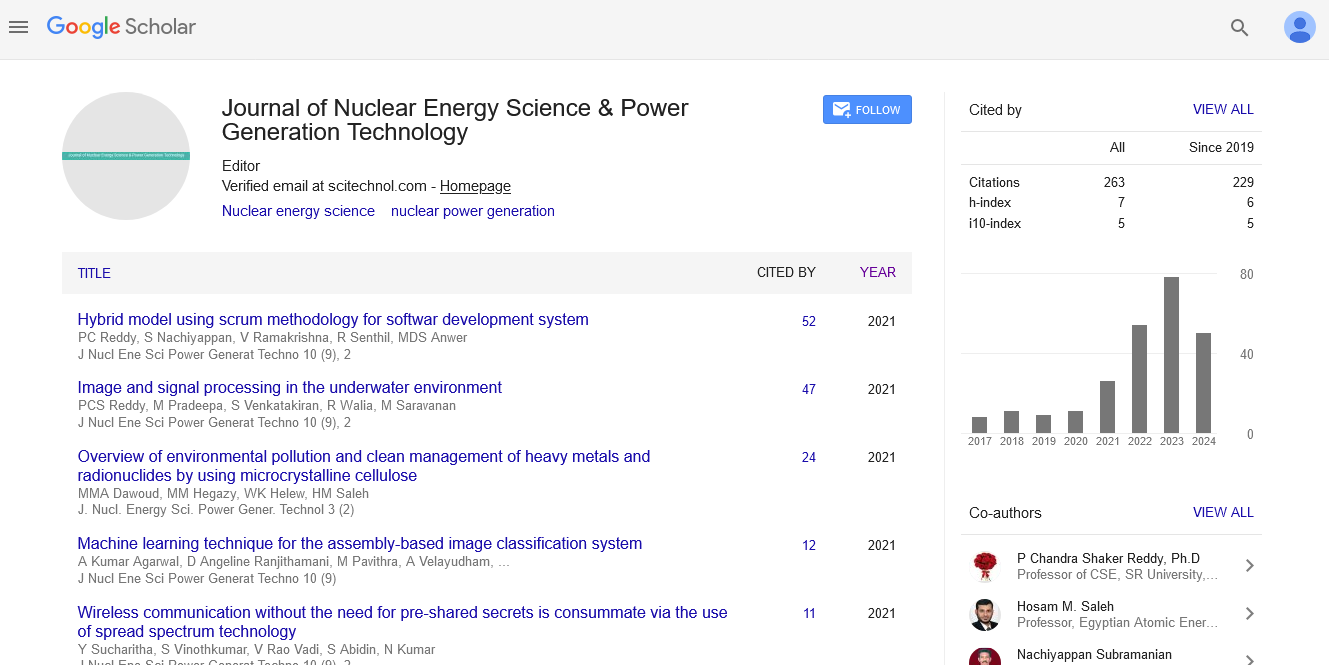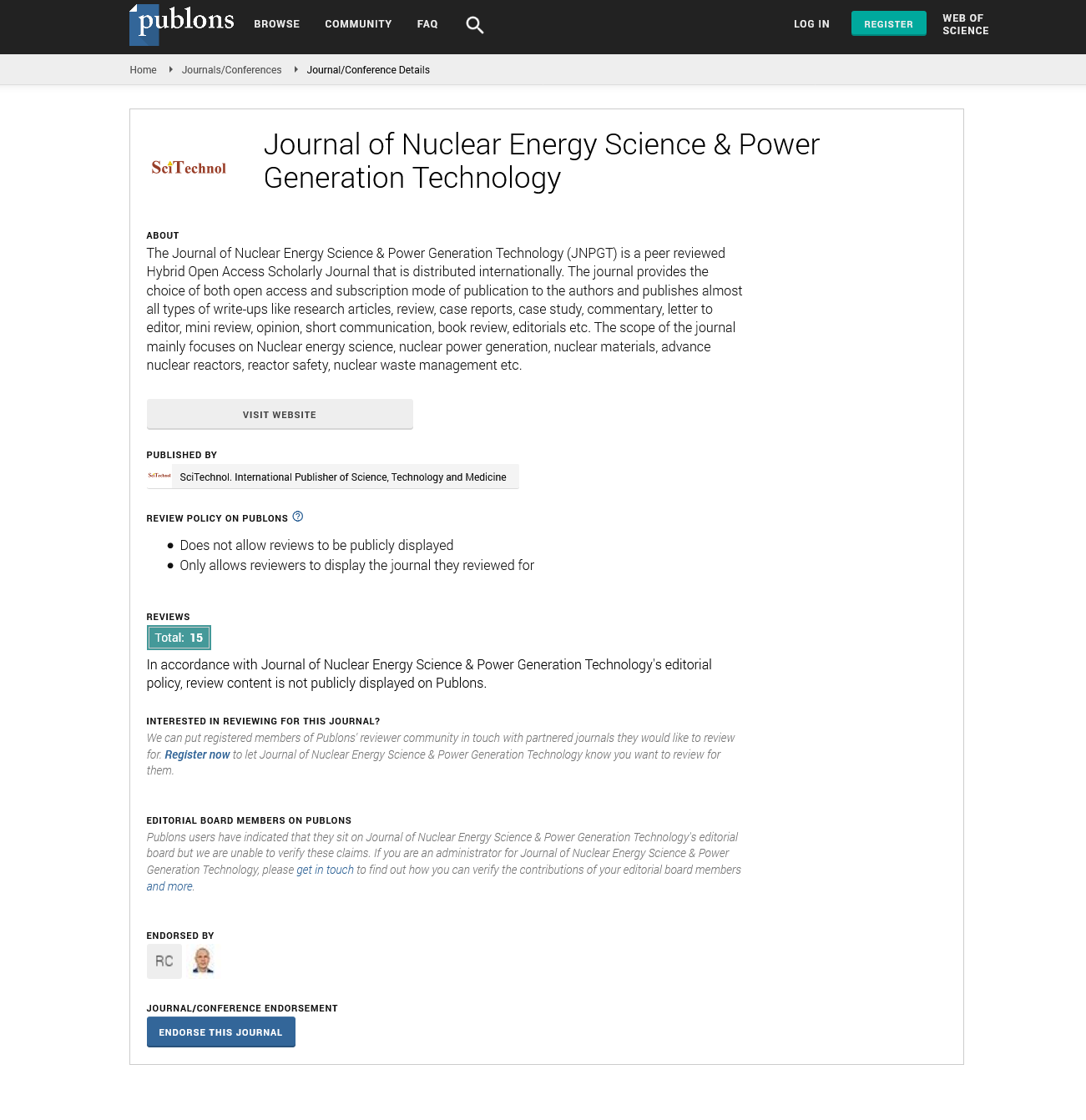Commentary, J Nucl Ene Sci Power Generat Technol Vol: 13 Issue: 4
Nanotechnology in Radiation Shielding: Potential and Challenges of Nano-Enhanced Materials
Kaiona Trein*
1Department of Nuclear Science and Engineering, East China University of Technology, Jiangxi, China
*Corresponding Author: Kaiona Trein,
Department of Nuclear Science and
Engineering, East China University of Technology, Jiangxi, China
E-mail: kaiona_trein@gmail.com
Received date: 17 June, 2024, Manuscript No. JNPGT-24-143339;
Editor assigned date: 19 June, 2024, PreQC No. JNPGT-24-143339 (PQ);
Reviewed date: 03 July, 2024, QC No. JNPGT-24-143339;
Revised date: 11 July, 2024, Manuscript No. JNPGT-24-143339 (R);
Published date: 18 July, 2024, DOI: 10.4172/2325-9809.1000406.
Citation: Trein K (2024) Nanotechnology in Radiation Shielding: Potential and Challenges of Nano-Enhanced Materials. J Nucl Ene Sci Power Generat Technol 13:4.
Description
Radiation shielding is a vital aspect of ensuring safety in environments where ionizing radiation is present. This includes applications in medical, industrial, nuclear power, and space exploration fields. Ionizing radiation consists of particles or electromagnetic waves that have enough energy to ionize atoms or molecules by detaching electrons. The most common types of ionizing radiation include alpha particles, beta particles, gamma rays, and neutrons. Each type poses different challenges for shielding due to their unique properties and interactions with matter. Alpha particles, composed of two protons and two neutrons, have a relatively large mass and charge, causing them to lose energy quickly when passing through matter. They can be stopped by a sheet of paper or the outer layer of human skin. However, if alpha-emitting materials are ingested or inhaled, they can cause significant internal damage. Thus, the primary concern for shielding alpha particles is preventing inhalation or ingestion through the use of respirators, gloves, and protective clothing. Beta particles are high-energy, high-speed electrons or positrons. They can penetrate further than alpha particles but are still relatively easy to shield. Materials like plastic, glass, or aluminum can effectively absorb beta particles. For example, a few millimeters of plastic or glass can stop most beta particles, while denser materials like aluminum may require only a thinner layer.
Gamma rays and X-rays are forms of electromagnetic radiation with high energy and no mass or charge, allowing them to penetrate deeply into materials. Shielding against gamma rays and X-rays requires dense materials with high atomic numbers, such as lead, tungsten, or depleted uranium. The effectiveness of shielding is determined by the material's thickness and density, which reduce the intensity of the radiation through a process called attenuation. Lead for instance, is commonly used in medical and industrial applications because of its high density and relatively low cost. In practice, the required thickness of lead shielding depends on the energy of the gamma rays and the desired level of protection. Neutron radiation, consisting of uncharged particles, interacts with matter primarily through elastic scattering and absorption reactions. Shielding neutron radiation is more complex due to the varied interactions with different materials.
Effective neutron shielding often involves materials that can both slow down and capture neutrons. Hydrogen-rich substances like water, polyethylene, and concrete are particularly effective because hydrogen atoms are similar in mass to neutrons, making them efficient at slowing down neutrons through collisions. Boron and cadmium are often used as additives in shielding materials due to their high neutron absorption cross-sections. Radiation shielding design considers multiple factors, including the type and energy of the radiation, the required level of protection, the distance from the radiation source, and the duration of exposure. The principle of As Low As Reasonably Achievable (ALARA) guides the design process, emphasizing the minimization of radiation exposure by optimizing shielding, exposure time, and distance. Spacecraft and habitats must be designed with lightweight yet effective shielding materials to protect astronauts during long-duration missions. Research is ongoing to develop advanced materials and technologies, such as hydrogen-rich polymers and magnetic shielding, to address these challenges.
Conclusion
In conclusion, radiation shielding is a multifaceted discipline that requires a deep understanding of the properties of ionizing radiation and the interactions of different materials with these radiations. Effective shielding strategies are essential for ensuring safety across various fields, from healthcare and nuclear power to space exploration and industrial applications. Advances in materials science and engineering continue to enhance our ability to protect against radiation, contributing to safer environments and enabling the beneficial use of radiation in technology and medicine. Radiation shielding is also vital in industrial applications where radioactive materials are used, such as in non-destructive testing, radiography, and nuclear medicine. Proper shielding ensures the safety of workers and the public while allowing these technologies to be used effectively.
 Spanish
Spanish  Chinese
Chinese  Russian
Russian  German
German  French
French  Japanese
Japanese  Portuguese
Portuguese  Hindi
Hindi 

